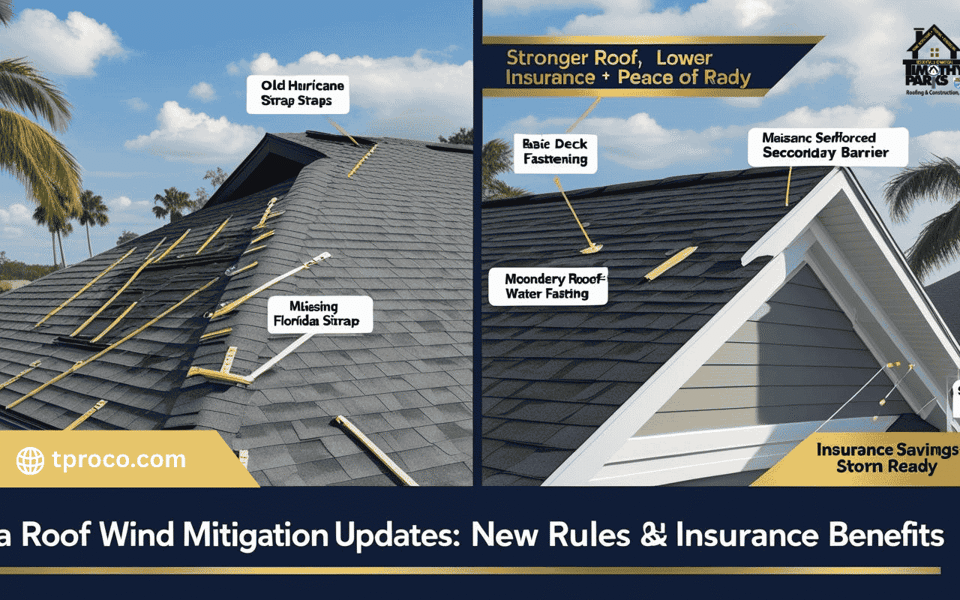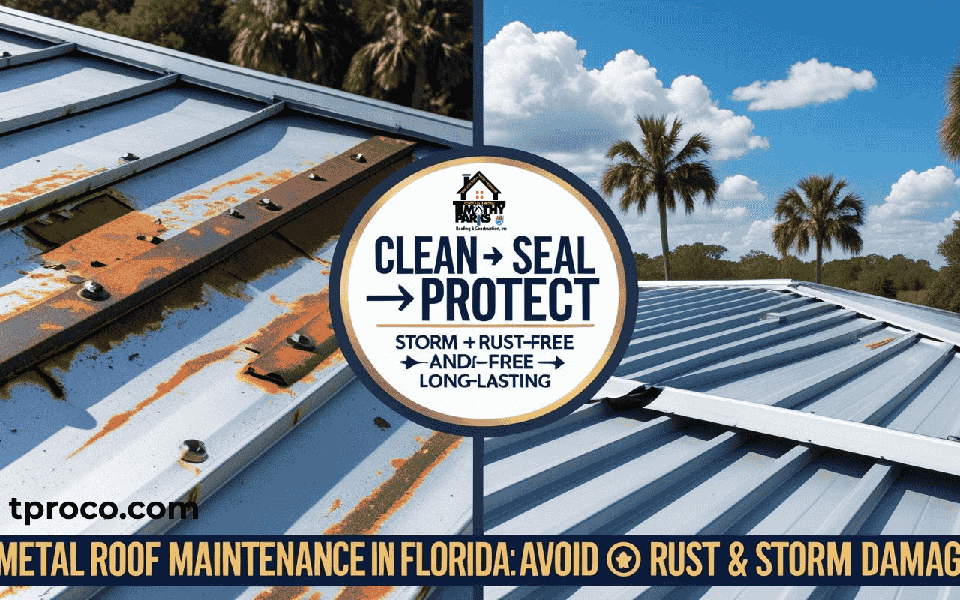Our Blogs
Repairing Storm-Damaged Chimneys in Florida: Seal Out Leaks & Reinforce Brick 🔥
Florida’s storms aren’t just tough on roofs—they can wreak havoc on chimneys as well. High winds, flying debris, and driving rain can crack mortar joints, loosen bricks, and tear away the flashing where chimney meets roof. Left unrepaired, these gaps invite water intrusion, fostering rot in attic framing or causing moldy drywall around the fireplace. In this blog, we’ll explore chimney vulnerabilities in Florida’s storm-prone climate, how to identify damage (from hairline mortar cracks to missing bricks), and the best practices for resealing or rebuilding the chimney so it stands firm against the next squall. A secure chimney doesn’t just keep water out; it also preserves your home’s structural integrity and curb appeal.

Why Florida Chimneys Face Unique Storm Risks
Although Florida’s mild winters mean chimneys aren’t used as heavily for heating, they still endure:
- Wind-Driven Rain: Vertical walls like a chimney can catch gusts that push water into mortar cracks or the flashing edge.
- Salt Air Corrosion (Coastal Areas): Bricks, mortar, and metal flashing degrade faster if you’re near the ocean.
- Hurricane Debris: Flying branches or loose objects can chip or crack chimney bricks.
- Extreme Heat & UV: Florida’s sun can cause mortar shrinkage and hairline cracks, letting storms exploit these vulnerabilities.
Over time, small gaps become portals for moisture. If your chimney stands above the roofline (common in older or decorative builds), it catches the brunt of every storm’s wind load. Recognizing that Florida’s storms blow rain sideways, checking the chimney’s mortar joints and flashing is crucial. A single missing brick or unsealed seam might escalate into major leak damage inside your attic or walls.
Identifying Chimney Damage: Inspection Tips
When you suspect a chimney leak or storm impact, begin with a thorough inspection:
- Exterior Visual Check: Walk around the chimney, looking for missing mortar or loose bricks. Run a hand over the surface—crumbly or sandy mortar indicates weakness. If the chimney is too tall, consider binoculars or a drone for safer distance viewing.
- Flashing Assessment: Chimney flashing typically consists of step flashing and counter-flashing. Torn or rusted metal, or gaps where flashing no longer sits flush, signal high risk for leaks.
- Crown & Cap Condition: If your chimney has a concrete crown, check for cracks or hairline fissures that can absorb water. A damaged chimney cap or spark arrestor can let rain directly down the flue.
- Attic Peek (If Accessible): Inspect where the chimney penetrates the roof. Look for water stains, mold patches, or damp insulation. Storm-driven water often travels down the chimney’s sides, rotting nearby rafters.
- Interior Fireplace Check: Discoloration, peeling paint, or musty odors near the firebox might indicate moisture infiltration from above.
In Florida, even minor cracks let wind-driven rain infiltrate. Because storms can saturate bricks over hours, you might not see an active leak until days later. Promptly noting these signs ensures you can tackle the root cause—be it mortar failure, flashing separation, or a poorly sealed crown—before the next downpour compounds damage.
Mortar Joint & Brick Repairs
Once you confirm mortar deterioration or damaged bricks:
Tuckpointing Mortar Joints:
Remove loose or crumbly mortar to a depth of about 1/2"–3/4". Use a chisel or tuckpointing tool. Then pack fresh mortar designed for chimney/masonry repair. Florida’s humidity demands a mortar mix that cures well in moist conditions—often Type S or M with water-repelling additives.
Replacing Cracked Bricks:
If individual bricks are severely chipped or fractured, carefully remove them. Soak replacement bricks in water briefly to prevent rapid moisture absorption from the new mortar. Install them flush with existing courses for a uniform look.
Blending Colors & Textures:
Florida’s bright sun can fade older bricks. If aesthetics matter, consider staining or selecting close color matches. Let the new mortar cure fully before pressure washing or sealing.
Sealing Brick Surfaces:
A breathable masonry sealer can help repel wind-driven rain. Avoid sealers that trap moisture inside the brick. Instead, pick a vapor-permeable product suitable for Florida’s humidity.
Tuckpointing and partial brick replacement restore the chimney’s structural integrity, preventing water from creeping through compromised mortar. If you skip these steps, you might fix the flashing but still have water infiltration via rotted mortar lines. A thorough job ensures your chimney remains a watertight fortress, not a water funnel, when storms roll in.
Flashing Replacement & Waterproofing
Even if bricks are solid, failing flashing invites leaks:
Remove Old Flashing:
Carefully loosen shingles around the chimney base. Pry out corroded or bent metal pieces. Preserve the chimney’s mortar joints if possible—excess chiseling can weaken the structure.
Install Step & Counter-Flashing:
Step flashing weaves with each shingle course, while counter-flashing inserts into a mortar groove or corner, covering the step flashing’s top edge. This layered approach ensures water flows over each metal piece, never behind it.
Sealant & Mortar Patching:
If you cut into mortar to embed counter-flashing, re-seal that groove with roofing-grade caulk or fresh mortar. Gaps here undermine the entire system.
Waterproofing Membrane (Optional):
In Florida’s heavy rains, adding peel-and-stick membrane around the chimney base is wise. It acts as a backup barrier if strong winds push water under shingles.
A properly installed flashing system is your chimney’s top defense. Done incorrectly, water seeps behind the metal edges or under shingles, leading to rot or interior staining. Ensure each metal piece overlaps the next, and that final edges are sealed. Next time wind-driven rain hits your chimney, it’ll roll away instead of sneaking inside.
Chimney Crown & Cap Fixes
The chimney crown (the concrete or mortar top) and cap (metal or ceramic piece covering the flue) also require attention:
- Repair Crown Cracks: Hairline cracks expand under Florida’s heat and rain cycles. Use a flexible, waterproof crack filler or re-coat the crown with a specialized sealant designed for chimney tops.
- Install/Replace Cap: A chimney cap prevents rain, debris, and animals from entering. If yours is missing or damaged, water can pool in the flue. Caps with spark arrestors help prevent stray embers if you do use the fireplace occasionally.
- Sloped Crown Design: Ensure the crown slopes outward to direct water off the chimney sides. Flat surfaces pool water, accelerating mortar decay.
A robust crown and a well-fitted cap keep moisture from dropping down the flue or saturating the top bricks. Coupled with secure flashing and mortar joints, you’ll have a fully shielded chimney that shrugs off Florida storms instead of soaking them in.
Waterproof Coatings & Final Testing
After structural and flashing repairs, apply waterproofing as the finishing step:
- Breathable Masonry Sealers: Look for silane/siloxane-based products that allow vapor to escape but block rain infiltration. This helps bricks shed water during storms yet dry out after.
- Coat the Entire Chimney Above Roofline: Overlap slightly below the flashing. Two coats might be necessary for porous bricks.
- Water Test: Gently spray the chimney with a garden hose, simulating rainfall. Check inside the attic or the fireplace area for any drips or dampness.
If everything remains dry, your chimney is likely watertight. Just remember that Florida’s climate demands periodic checkups—especially after a rough hurricane season. Reapply sealer every few years to maintain protection. This final layer ensures your newly repointed bricks, fresh flashing, and sealed crown all function as a cohesive defense system against driving rain.
Conclusion
🔥 Florida storms can quickly turn a neglected chimney into a major leak source—ruining interior walls, rotting roof decking, or even undermining the entire fireplace structure. By proactively repairing cracked mortar, replacing damaged bricks, installing snug flashing, and waterproofing the masonry, you’ll keep your chimney robust and watertight. A stable, sealed chimney not only prevents water intrusion but also preserves your home’s exterior charm. After all, your roofline is a prime visual element—why let cracks and stains define it? With thorough inspections and timely fixes, your chimney stays strong despite Florida’s fiercest winds and rain, ensuring peace of mind all year.
Frequently Asked Questions (FAQ)
🔥 Protect Your Chimney from Florida’s Next Storm!
Cracked mortar or torn flashing? Learn how to seal, repair, and storm-proof your chimney to keep your home safe from leaks and structural damage.
#tproco #tppro #tprci #urro #rrfl
#ChimneyRepair #MortarJointFix #FloridaStormPrep #TampaChimney #OrlandoRoof #SunshineState
Schedule a Free InspectionAbout the Author

Timothy Parks
CEO
📢 Stay Informed: Communication & Consent Updates
At Timothy Parks Roofing & Construction Inc., we prioritize transparency in our communications. By submitting a request, you agree to receive calls, texts, and emails regarding our services. Standard messaging rates may apply. You can opt-out at any time by replying STOP or contacting us directly.
✅ Florida License: #CBCO59592, #CCC1327217, #HI4878
📌 Privacy & Terms: Read our Privacy Policy and Terms of Service.




